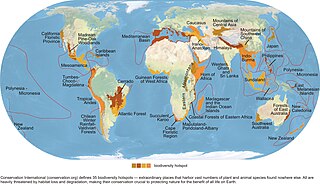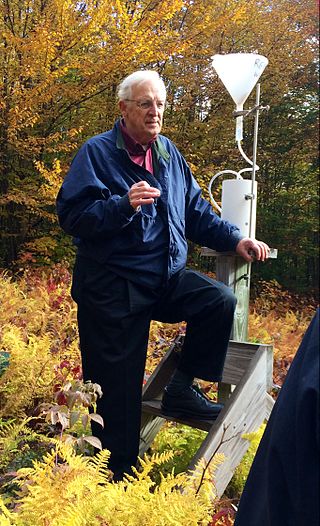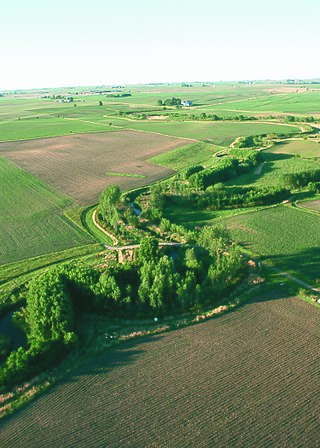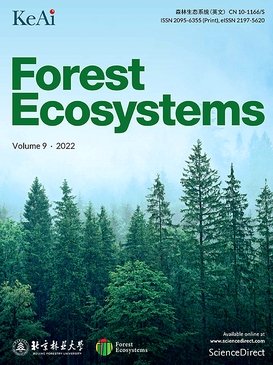
An ecosystem consists of all the organisms and the physical environment with which they interact. These biotic and abiotic components are linked together through nutrient cycles and energy flows. Energy enters the system through photosynthesis and is incorporated into plant tissue. By feeding on plants and on one another, animals play an important role in the movement of matter and energy through the system. They also influence the quantity of plant and microbial biomass present. By breaking down dead organic matter, decomposers release carbon back to the atmosphere and facilitate nutrient cycling by converting nutrients stored in dead biomass back to a form that can be readily used by plants and microbes.

Biodiversity or biological diversity is the variety and variability of life on Earth. Biodiversity is a measure of variation at the genetic, species, and ecosystem level. Biodiversity is not distributed evenly on Earth; it is usually greater in the tropics as a result of the warm climate and high primary productivity in the region near the equator. Tropical forest ecosystems cover less than 10% of earth's surface and contain about 90% of the world's species. Marine biodiversity is usually higher along coasts in the Western Pacific, where sea surface temperature is highest, and in the mid-latitudinal band in all oceans. There are latitudinal gradients in species diversity. Biodiversity generally tends to cluster in hotspots, and has been increasing through time, but will be likely to slow in the future as a primary result of deforestation. It encompasses the evolutionary, ecological, and cultural processes that sustain life.

An algal bloom or algae bloom is a rapid increase or accumulation in the population of algae in freshwater or marine water systems. It is often recognized by the discoloration in the water from the algae's pigments. The term algae encompasses many types of aquatic photosynthetic organisms, both macroscopic multicellular organisms like seaweed and microscopic unicellular organisms like cyanobacteria. Algal bloom commonly refers to the rapid growth of microscopic unicellular algae, not macroscopic algae. An example of a macroscopic algal bloom is a kelp forest.

Human ecology is an interdisciplinary and transdisciplinary study of the relationship between humans and their natural, social, and built environments. The philosophy and study of human ecology has a diffuse history with advancements in ecology, geography, sociology, psychology, anthropology, zoology, epidemiology, public health, and home economics, among others.

Urban ecology is the scientific study of the relation of living organisms with each other and their surroundings in an urban environment. An urban environment refers to environments dominated by high-density residential and commercial buildings, paved surfaces, and other urban-related factors that create a unique landscape. The goal of urban ecology is to achieve a balance between human culture and the natural environment.

Water pollution is the contamination of water bodies, usually as a result of human activities, so that it negatively affects its uses. Water bodies include lakes, rivers, oceans, aquifers, reservoirs and groundwater. Water pollution results when contaminants mix with these water bodies. Contaminants can come from one of four main sources: sewage discharges, industrial activities, agricultural activities, and urban runoff including stormwater. Water pollution is either surface water pollution or groundwater pollution. This form of pollution can lead to many problems, such as the degradation of aquatic ecosystems or spreading water-borne diseases when people use polluted water for drinking or irrigation. Another problem is that water pollution reduces the ecosystem services that the water resource would otherwise provide.

Urban forestry is the care and management of single trees and tree populations in urban settings for the purpose of improving the urban environment. Urban forestry involves both planning and management, including the programming of care and maintenance operations of the urban forest. Urban forestry advocates the role of trees as a critical part of the urban infrastructure. Urban foresters plant and maintain trees, support appropriate tree and forest preservation, conduct research and promote the many benefits trees provide. Urban forestry is practiced by municipal and commercial arborists, municipal and utility foresters, environmental policymakers, city planners, consultants, educators, researchers and community activists.

A subshrub or dwarf shrub is a short shrub, and is a woody plant. Prostrate shrub is a related term. "Subshrub" is often used interchangeably with "bush".

Habitat destruction is the process by which a natural habitat becomes incapable of supporting its native species. The organisms that previously inhabited the site are displaced or dead, thereby reducing biodiversity and species abundance. Habitat destruction is the leading cause of biodiversity loss. Fragmentation and loss of habitat have become one of the most important topics of research in ecology as they are major threats to the survival of endangered species.

Ecosystem services are the many and varied benefits to humans provided by the natural environment and healthy ecosystems. Such ecosystems include, for example, agroecosystems, forest ecosystem, grassland ecosystems, and aquatic ecosystems. These ecosystems, functioning in healthy relationships, offer such things as natural pollination of crops, clean air, extreme weather mitigation, and human mental and physical well-being. Collectively, these benefits are becoming known as ecosystem services, and are often integral to the provision of food, the provisioning of clean drinking water, the decomposition of wastes, and the resilience and productivity of food ecosystems.

An aquatic ecosystem is an ecosystem found in and around a body of water, in contrast to land-based terrestrial ecosystems. Aquatic ecosystems contain communities of organisms—aquatic life—that are dependent on each other and on their environment. The two main types of aquatic ecosystems are marine ecosystems and freshwater ecosystems. Freshwater ecosystems may be lentic ; lotic ; and wetlands.

Gene Elden Likens is an American limnologist and ecologist. He co-founded the Hubbard Brook Ecosystem Study at the Hubbard Brook Experimental Forest in 1963, and founded the Cary Institute of Ecosystem Studies in Millbrook, New York in 1983.

Prairie restoration is a conservation effort to restore prairie lands that were destroyed due to industrial, agricultural, commercial, or residential development. The primary aim is to return areas and ecosystems to their previous state before their depletion.
An online marketplace is a type of e-commerce website where product or service information is provided by multiple third parties. Online marketplaces are the primary type of multichannel ecommerce and can be a way to streamline the production process.

In ecology, urban ecosystems are considered a ecosystem functional group within the intensive land-use biome. They are structurally complex ecosystems with highly heterogeneous and dynamic spatial structure that is created and maintained by humans. They include cities, smaller settlements and industrial areas, that are made up of diverse patch types. Urban ecosystems rely on large subsidies of imported water, nutrients, food and other resources. Compared to other natural and artificial ecosystems human population density is high, and their interaction with the different patch types produces emergent properties and complex feedbacks among ecosystem components.

The World Resources Institute (WRI) is a global research non-profit organization established in 1982 with funding from the MacArthur Foundation under the leadership of James Gustave Speth. Subsequent presidents include Jonathan Lash, Andrew D. Steer and current president Ani Dasgupta (2021-).

Nature-based solutions (NBS) is the sustainable management and use of natural features and processes to tackle socio-environmental issues. These issues include climate change, water security, water pollution, food security, human health, biodiversity loss, and disaster risk management. The European Commission's definition of NBS states that these solutions are "inspired and supported by nature, which are cost-effective, simultaneously provide environmental, social and economic benefits and help build resilience. Such solutions bring more, and more diverse, nature and natural features and processes into cities, landscapes, and seascapes, through locally adapted, resource-efficient and systemic interventions". In 2020, the EC definition was updated to further emphasise that “Nature-based solutions must benefit biodiversity and support the delivery of a range of ecosystem services.” Through the use of NBS healthy, resilient, and diverse ecosystems can provide solutions for the benefit of both societies and overall biodiversity.
The Record Mirror Club Chart was a weekly chart compiled by British trade paper Music Week. It was published in their RM Dance Update, a supplemental insert, and was compiled from a sample of over 500 DJ returns.

Forest Ecosystems is a bimonthly peer-reviewed open access scientific journal covering research related to the structure and dynamics of "natural" and "domesticated" forest ecosystems. Previously published by Springer Nature, as of 2022 it is published by Elsevier on behalf of KeAi Communications.
















